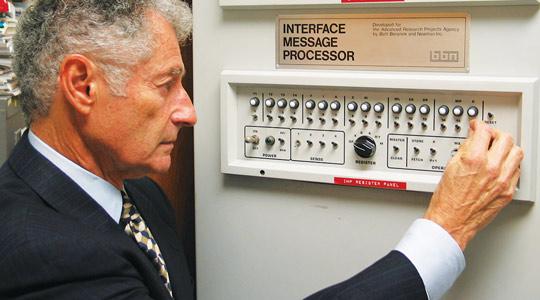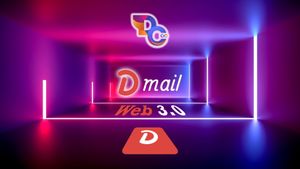Many may not be aware, but the electric printing telegraph (the predecessor to the fax machine) was patented in 1843. A few decades later, Leonard Kleinrock (pictured) 'was driven by a certainty that computers were destined to speak to each other'. The resulting network should be as simple to use as telephones, with the first 'email' being sent in 1969, albeit an incomplete word comprising two letters 'Lo'.
Fast forward to today, we have a multitude of email service providers, including:
Mainstream
- Google's Gmail
- Microsoft's Outlook
- Apples' iCloud Mail
Privacy Focussed
- Protonmail
- Tutanota
What all the above have in common is that they are all hosted on servers under their control (either in one location; for example, Protonmail is hosted out of servers based in Switzerland or around the world (Google / Microsoft / Apple).
Notwithstanding, these companies have managed to gain a significant amount of users over the years, with Gmail having around '1.5 billion active users worldwide'. This effectively means 1.5 billion Gmail users are happily sending and receiving emails every single day (or close to) and with no care in the world about potential privacy issues as long as Gmail is up and running.
So if it ain't broke, why fix it?

Dmail Network: First Decentralized Email on the Internet Computer
As the world's first mailbox product based on @dfinity blockchain, this is the first message
— Dmail Network (@dmailofficial) August 23, 2021
Dmail Network, a new decentralized NFT email infrastructure based on DFINITY, is designed for the Web 3.0 era catering to people’s new demands arising from the latest development of the Internet.
Source: Dmail blog
Admittedly, I did not hear about Dmail (not to be confused with the Dmail Chrome browser extension, which no longer exists) until reading an article about it here.
It appears that Dmail has been active for a few months leading up a Tweet in mid-September 2021 announcing that it had 'signed up for the official DFINITY Hackathon in October.'
And sure enough, Dmail delivered not only a demo version of Dmail but also won a 'Sponsored Prize' as part of Wanxiang Blockchain's Hackathon.

So What problem is Dmail trying to solve, and is there really a problem?
Dmail believes there are a few, including:
Continuity of service
In 2007, Mashable published a list of 75 email services that were not Gmail. Do you know how many of those email services have since closed down? 59 percent. That means that only two out of every five providers on the list are still operational.
Source: Atmail blog
Data ownership
One morning in April, my Yahoo email account was disabled for no apparent reason. In the seven weeks since my account was shut, I’ve spent about 12 hours on hold with Yahoo customer service and corresponded with the company at least 15 times.
And I still don’t have my email account back.
Since then, I’ve learned it wasn’t a security threat that was the problem. It was a question of ownership. And, if your email account is terminated, don’t expect to revive it.
Source Reuters
Privacy concerns
Much of the information collected by Gmail and shared with advertisers is metadata – data about data. But if you carry cookies from other Google services, your activity can be correlated or “fingerprinted” from associated products such as Google Maps and YouTube.
Source: The Guardian
- Advertisement overload
Companies want you to buy their stuff, and email is a good way to get it in front of you.
Source: The Atlantic
Lack of decentralized email standards on Web3
'With the development of the era of Web3.0, traditional emails did not catch up
with the upgrading of the blockchain. Hence, Dmail has done a lot of research to solve this problem, hoping to bridge the Web3.0 era and traditional Internet in a new way so as to help more traditional Internet users to access blockchain with lower barrier of entry.'
At the moment, there is no bridge between traditional and decentralized emails making sending/receiving emails between, say, a dApp and Gmail very challenging.
Source: Dmail Lite paper
Why build on the Internet Computer?
Today, only 1 (one) blockchain runs smart contracts in parallel...
— Dominic Williams ∞ (@dominic_w) October 29, 2021
IMPORTANT FACT: parallelization is REQUIRED for seamless infinite smart contract scaling.
Much more complex. Only 1 can do it. #InternetComputer
Before discovering how Dmail can solve the problems identified, we should probably consider why Dmail has leveraged the Internet Computer to solve these problems.
'Compared with the existing services, the biggest advantage of Dmail is its high-level data security.
Compared with other public chains, its advantage lies in the construction of seamless connections of various applications and unlimited performance.'
Source: Dmail Medium
You may also wonder why the Internet Computer was chosen over other blockchains, given that dApps built on most blockchains address a majority of the problems identified earlier. Well, let's just say the Internet Computer does things a little better than the others.
In particular, Dmail considers the following as the main reasons for building on the Internet Computer:
1. Low gas fees
Who wants to pay for every action and/or email sent? Here, there is no need for any payment to be made when interfacing with dApps built on the Internet Computer due to its reverse gas fee model. Imagine having to pay a fee (no matter how small) every time you need to send and/or receive an email.
2. Strong Scalability
Dmail believes that DFINITY is well ahead (compared to, say, ETH 2.0) in terms of 'sharding' whereby subnets (or shards) on the Internet Computer can be merged, removed and in particular added (as network demand grows) without 'the need to stop Dapp services during the expansion process.'
3. Inter-operability
Chain key cryptography opens up a world of possibilities for dApps to inter-operate with dApps on the Internet Computer, with dApps on other blockchains including Ethereum (and more so with the planned direct integration with Ethereum).
In addition to the above, Dmail is developing a new standard based on MIME specifically to bridge Dmail (and/or any other decentralized email application on the Internet Computer) with traditional email.
'A complete block chain data structure is defined on the basis of RFC8555 protocol to solve the above issues. Dmail is submitting the standard and solution to the IANA'
Source Dmail Medium
So How is Dmail going to solve these problems?
User data on traditional email providers are stored on centralized servers, which in itself contributes to all the problems that Dmail is trying to solve.
At a high level, Dmail's proposed solution to these problems is as follows:
- Continuity of service / Data Ownership
Dmail is planning to be governed as a Decentralized Autonomous Organisation (DAO) in Q2 2022, according to its roadmap. With the proposed Service Nervous System due to be launched, it is very likely that Dmail could be converted into a DAO, ensuring no one centralized authority controls Dmail, therefore ensuring continuity of service.
This is in addition to the fact that Dmail is built on the Internet Computer, which in itself is a web3 decentralized platform with no centralized server and/or controlling authority that can shut down service.
- Privacy concerns / Advertisement Overload
In addition to the Internet Computer's core tech (VRF and BLS) driving its consensus mechanism ensuring data security and speed, user's private data is also encrypted and stored on-chain in a user's private canister (which in itself is already very secure) discussed later.
Dmail also allows users to use an 'alias' instead of a user's actual Dmail address to ensure further privacy.
The user sets the alias to replace the chain address as the mail account. The user does not need to expose the chain address to other users during non-asset interaction. For example, alice@Dfinity.domain.com is the same as staghkhshsooxXmcg6HJuHvJJKougzt...@ Dfinity.domain.com.
Source: Dmail Deck

What makes Dmail unique?
Dmail is not only going to be an email dApp similar to what we already have in the traditional email space but. in addition to this:
- Users can securely log in using, say, Internet Identity (no more passwords)
- Each email address (created and allocated automatically to each user whereby a user can create an alias to 'avoid unnecessary exposure of the chain address") will be being a fully-tradeable NFT in its own right.
- Users can seamlessly send emails (including attachments) to traditional email addresses (and vice versa).
- Dmail will have an in-built wallet capable of storing and sending not only ICP but also NFTs (and airdrops direct into a user's Dmail wallet).
- Open API whereby other dApps can seamlessly integrate with Dmail including access to external NFT marketplaces (including ICPunks, Entrepot (potential), OpenSea (cross-chain), etc.).
- Potential DeFi functionality, including staking capabilities.
- Governed by the community via a DAO.
- Distributed 'cloud storage.'
Users can upload private, valuable and attachments that need to be saved for a long-term to cloud disk storage for calling and querying at any time.
How does Dmail work?
Canister allocation

When an account is first created with Dmail, a canister is allocated as storage space for a user's personal data, which will be encrypted and stored through an encryption algorithm. Only the user can call and view data on a user-allocated canister for purposes of privacy and data sovereignty.
Dmail message
According to Dmail, a user's email is split into:

-
Header
This is the header of the email, which is stored separately 'on-chain' (in the form of a 'hash') from the email's body (containing the email message) -
Body
The actual email message itself (the body) is then encrypted using a 'token' and stored in a distributed manner across several canisters using 'Bigmap' which allows for 'multiple backups of multiple containers to achieve rapid space expansion and the balance of storage security' according to Dmail.
Recipients of an email can be decrypted by a receiving party using the same 'token'.
Given Dmail is still being developed, further information is required to determine how this 'token' mechanism will work in reality including how this fits in with the overall big picture (refer to the diagram below).

Sources:

Demo Walkthrough
Dmail has launched a demo of its Dmail dApp, which is running entirely on the Internet Computer. Although many of its functions cannot be used, one can still send emails back to Dmail and/or to a traditional email provider.
This was confirmed by the author, who sent a test email to his personal Gmail account followed up with a reply from Gmail back to Dmail, both of which were successful.
You can also check out a quick walkthrough (no sound) of the Dmail dapp below and/or, even better, try it out yourself here.
Composing and Sending an EMail
Testing out Other Parts
Roadmap of the Project

'The blockchain mailbox will not be particularly different from the traditional mailbox, but according to the development roadmap of Dmail, it will experience the conversion from a single-function mailbox to an asset trading platform.'
Source: Dmail Medium
Dmail has laid out a Roadmap, albeit with a very tight schedule, which sees it develop from a developer-controlled emailing dApp to a community/DAO-controlled multi-blockchain platform compatible emailing and asset trading dApp within the next year or so.
The ability to hold and trade NFTs within Dmail sounds very exciting, however, Dmail has no plans (at this stage) to allow users to create NFTs out of email content (stored within the body of a message) which could potentially be useful in the commercial/legal sector where email messages themselves could potentially form binding-contracts between parties.
Notwithstanding, if the Roadmap progresses according to plan, Dmail has the potential to be one of the major dApps within the Internet Computer ecosystem.
Competitors of Dmail

By now, you must be wondering surely someone somewhere would have already developed a fully functioning decentralized dApp on any of the other blockchains. So we did a quick Google search with the first result being 'Ledgermail' which touts itself as the 'world's first decentralized email solution' built on a little known Xinfin blockchain network.
Upon further research, we found that although Ledgermail (launched earlier this year) was indeed the first email solution on a blockchain, it had one major flaw:
'The single largest problem with LedgerMail, however, is that it’s a closed-loop system. That is to say, users can only deliver messages to other people that own a LedgerMail account - and even then, only if they feature on the recipient’s approved list of contacts.'
Source: Techradar
According to Ledgermail's website, users can still receive email from traditional email providers, however, 'emails which are not sent through LedgerMail will still get received in your inbox, however, they won’t be encrypted or decentralized.'
Conclusion

Even if Ledgermail's claims of being the First decentralized email solution are valid (if you know of any other decentralized email services, please let us know), this will make Dmail (once launched) the First fully decentralized (and DAO-controlled) email service. It will send and receive emails (with no gas fees payable by the user) in a secure and decentralized manner.
Dmail will enable a seamless service between the Internet Computer and traditional email providers and be able to store and transact ICP, ETH, NFTs, etc., within the Internet Computer ecosystem and with other blockchains.
We are truly excited about the possibilities Dmail will bring to the Internet Computer ecosystem and the entire blockchain industry, including bringing in new users from the traditional stack into the Internet Computer.
Dmail Network will be an enhanced, unhackable, and tokenized email for the web3 era, and we cannot wait!
Connect with DMail here:
Dmail Lite Paper PDF | Medium | Dmail Discord | Twitter | GitHub | Telegram
Website: https://dmail.ai/ | Pitch Deck | Demo dapp |
Connect With Us:
Twitter | Telegram | Instagram | Facebook | Email

- Disclaimer: The views and opinions expressed on this website are solely those of the original author and other contributors. These views and opinions do not necessarily represent those of the Dfinity Community staff and/or any/all contributors to this site.



Comments are for members only. Join the conversation by subscribing 👇.